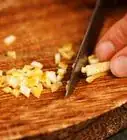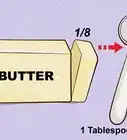This article was co-authored by wikiHow Staff. Our trained team of editors and researchers validate articles for accuracy and comprehensiveness. wikiHow's Content Management Team carefully monitors the work from our editorial staff to ensure that each article is backed by trusted research and meets our high quality standards.
wikiHow marks an article as reader-approved once it receives enough positive feedback. In this case, 95% of readers who voted found the article helpful, earning it our reader-approved status.
This article has been viewed 556,940 times.
Learn more...
Orange zest is made from the top layer of an orange's peel. It contains the fruit's oils and adds a bright, citrus flavor to a dish or recipe. There are several kitchen utensils you can use to zest an orange, including a grater, microplane, vegetable peeler, or knife. Before you zest an orange, be sure to wash the fruit thoroughly with water and a drop of dish soap, and scrub the skin with your fingers or a brush!
Steps
Grating the Zest
-
1Position the end of the grater on the cutting board. If you are using a flat grater, hold the grater at an angle, with one end resting against the cutting board. If you are using a box grater, simply place the grater on top of the cutting board.[1]
- This will stabilize the grater for easier zesting, and it will allow you to see how much zest you’ve made as you’re working.
-
2Scrape the orange along the grater from top to bottom. Drag the orange along the grater toward the cutting board, maintaining enough pressure to remove the top layer of the rind. Once you reach the end of the board, lift up the orange and place it at the top of the zester again.[2]
- Try to avoid pulling the orange from the bottom of the zester to the top, which can clog the holes or damage the skin of the orange.
- If you’re having trouble holding the orange while you zest it, cut the orange in half and squeeze the juice into a cup to make it smaller and easier to hold in your hand. Without the juice in the orange, the rind will be more pliable, and you can mold it into a shape that’s comfortable for you to hold.
Advertisement -
3Rotate the orange when you reach the white rind. Once you reach the white part, call the “pith,” rotate the orange to a different spot on the rind. Normally, you’ll reach the pith after zesting an area 1-2 times, and then turn the orange slightly to continue zesting.[3]
- The pith of the orange has a bitter taste, which is unpleasant for most recipes. If you do end up accidentally zesting the pith, stop and pick the white parts out of the zest.
-
4Transfer your zest to a measuring cup once you’ve used the entire rind. When you have a large pile of zest on the cutting board, scoop it into a measuring spoon to see how much you have. If you have enough for your recipe, set your zested oranges aside to use the juice or flesh later.[4]
- One medium-sized orange should yield about 1-1.5 tablespoons (6-9 grams) of zest.
- If you need more for your recipe, wash another orange to zest some more.
Zesting with a Microplane
-
1Hold the microplane at an angle. Rest the tip of the microplane against your cutting board, and hold the handle in your non-dominant hand. This will help to stabilize the microplane while you use it, and it will gather the zest in one place while you work.[5]
- Avoid trying to zest directly into a measuring cup, since the microplane will gather the zest in the long groove under the plane until it falls onto the board.
-
2Slide the orange along the microplane with light pressure. Lightly press the orange against the microplane and scrape it from the handle toward the cutting board. Maintain enough pressure to remove the top layer of the rind.[6]
- If you press too hard on the orange, you can clog the microplane with large chunks of orange rind. Maintain a light pressure to keep the zest pieces small and manageable.
-
3Turn the orange slightly after every 1-2 scrapes. After each scrape, check the orange rind to make sure the white pith isn’t showing. When you start to see it, rotate the orange slightly to zest a new part of the rind. Avoid using any section of the orange more than 2 times, since you don't want pith mixed in with your zest.[7]
- The pith has a bitter taste, so be sure to remove any white pieces from your zest if you accidentally zest the pith.
-
4Remove the zest from the groove underneath the microplane. Once you’ve zested the entire orange, turn the microplane over, and use a knife to scrape the zest into a measuring spoon.[8]
- You should be able to gather at least 1 tablespoon (6 grams) of zest from your orange. If you need more than that for your recipe, wash another piece of fruit and keep zesting!
Using a Vegetable Peeler or Knife
-
1Hold the peeler or knife against the skin and slide it across the rind. Press down hard enough so that you remove the top layer of the rind, using the same motion that you would to peel a potato. Make sure that the peeler or knife is just slightly under the skin, but not touching the pith.[9]
- After your first peel, check the zest to make sure there’s no white pith. If there is, throw that piece away and use less pressure for your next peel.
-
2Move to a new section of the orange after every peel. When using a zester or knife, only peel each section 1 time to avoid cutting into the pith. Spin or rotate the orange to find a fresh section of the rind to peel each time.[10]
- When you’re using a peeler, you can get very long pieces of zest. These are perfect for cocktail recipes, or using as a garnish on a plate.
-
3Chop the peel into smaller pieces for use in a recipe. If you’re recipe calls for a finer zest, use a sharp knife to chop or mince the peeled pieces to a smaller size. Be careful when cutting the peeled pieces, as they can be curly and need to be held in place. As you work, measure out the amount needed for your recipe.[11]
- If you have one available, a small food processor can quickly and easily chop longer pieces of zest.
Community Q&A
-
QuestionWill a cheese grater work?
 Community AnswerIf you have the kind of cheese grater that has a side with smaller holes, about the size of the tip of a pen as opposed to the width of a pencil erase, the small-holed side works great! Just make sure to not zest too far into the white part or it will be bitter.
Community AnswerIf you have the kind of cheese grater that has a side with smaller holes, about the size of the tip of a pen as opposed to the width of a pencil erase, the small-holed side works great! Just make sure to not zest too far into the white part or it will be bitter. -
QuestionCan I do the same for lemons?
 Community AnswerYes, you can do the same with lemons.
Community AnswerYes, you can do the same with lemons. -
QuestionWhat orange has the most flavorful zest?
 Samantha L. CampbellCommunity AnswerIn general, the flavor of the zest depends on the recipe. If you want a bolder flavor, try adding extra zest to your recipe. For a sweet flavor, try an "acid-less" orange, like a Navel or Valencia orange. For a bitter flavor, use a Seville orange.
Samantha L. CampbellCommunity AnswerIn general, the flavor of the zest depends on the recipe. If you want a bolder flavor, try adding extra zest to your recipe. For a sweet flavor, try an "acid-less" orange, like a Navel or Valencia orange. For a bitter flavor, use a Seville orange.
Things You’ll Need
- Cutting board
- Grater, microplane, vegetable peeler, or paring knife
- Measuring spoon
References
- ↑ https://www.thekitchn.com/how-to-zest-a-lemon-cooking-lessons-from-the-kitchn-198570
- ↑ https://www.thekitchn.com/how-to-zest-a-lemon-cooking-lessons-from-the-kitchn-198570
- ↑ http://www.slate.com/articles/life/food/2013/12/how_to_zest_citrus_with_a_microplane_grater_video.html
- ↑ http://bakingbites.com/2017/01/how-much-zest-does-citrus-lemon-yield/
- ↑ https://www.thekitchn.com/how-to-zest-a-lemon-cooking-lessons-from-the-kitchn-198570
- ↑ http://www.slate.com/articles/life/food/2013/12/how_to_zest_citrus_with_a_microplane_grater_video.html
- ↑ http://www.slate.com/articles/life/food/2013/12/how_to_zest_citrus_with_a_microplane_grater_video.html
- ↑ https://www.thekitchn.com/how-to-zest-a-lemon-cooking-lessons-from-the-kitchn-198570
- ↑ https://www.thekitchn.com/how-to-zest-a-lemon-cooking-lessons-from-the-kitchn-198570
About This Article
"To zest an orange, first place your grater on top of a cutting board. If you don't have a grater, you can use a microplane instead. Next, take the orange and gently scrape it along the grater from top to bottom. Once you reach the white rind, rotate the orange slightly and repeat. Keep doing this until you've grated off all of the orange skin on the outside of the fruit. "



















































